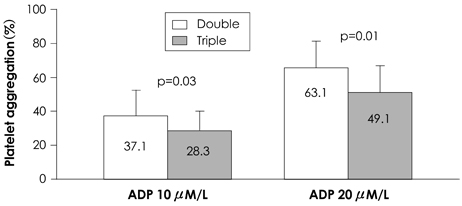Korean Circ J.
2009 Nov;39(11):462-466. 10.4070/kcj.2009.39.11.462.
Comparison of Triple Anti-Platelet Therapy (Aspirin, Clopidogrel, and Cilostazol) and Double Anti-Platelet Therapy (Aspirin and Clopidogrel) on Platelet Aggregation in Type 2 Diabetic Patients Undergoing Drug-Eluting Stent Implantation
- Affiliations
-
- 1Division of Cardiology, Department of Internal Medicine, Inje University College of Medicine, Cardiovascular Research Institute, Busan Paik Hospital, Busan, Korea. yangthmd@naver.com
- KMID: 2225648
- DOI: http://doi.org/10.4070/kcj.2009.39.11.462
Abstract
- BACKGROUND AND OBJECTIVES
Triple anti-platelet therapy may produce more potent inhibition of platelet aggregation in patients undergoing coronary stent implantation. We tested whether this effect could be maintained in diabetic patients, where platelet reactivity is increased and the risk of stent thrombosis is higher.
SUBJECTS AND METHODS
Fifty five type 2 diabetic patients who had undergone drug-eluting stent (DES) implantation and chronic anti-platelet therapy (>1 month) were stratified according to the status of anti-platelet therapy. Platelet aggregation after adenosine diphosphate (ADP; 10 micronmol/L and 20 micronmol/L) stimulation was compared using light transmittance aggregometry between dual (aspirin plus clopidogrel, n=34) and triple therapy (aspirin, clopidogrel plus cilostazol, n=21) groups.
RESULTS
The 2 groups had similar clinical and procedural characteristics. Maximal ADP-induced platelet aggregation was significantly lower in the triple therapy group than the dual therapy group (ADP 10 micronmol/L, 37.1+/-15.4 vs. 28.3+/-11.8, p=0.03; ADP 20 micronmol/L, 63.1+/-15.0 vs. 49.1+/-15.1, p=0.01), but there were no differences in diabetic treatment (oral hypoglycemic agent vs. insulin) or diabetic control {hemoglobin Alc (HbA1c)< or =7 vs. HbA1c >7}.
CONCLUSION
Triple anti-platelet therapy showed more potent inhibition of maximal ADP induced platelet aggregation in type 2 diabetic patients receiving chronic anti-platelet therapy. This finding suggests that triple antiplatelet therapy may be more effective in preventing thrombotic complications after DES implantation in type 2 diabetic patients.
MeSH Terms
Figure
Reference
-
1. Beckman JA, Creager MA, Libby P. Diabetes and atherosclerosis: epidemiology, pathophysiology, and management. JAMA. 2002. 287:2570–2581.2. Kim W, Jeong MH, Kim KH, et al. Long-term clinical and angiographic results of coronary stenting in diabetic patients. Korean Circ J. 2001. 31:24–30.3. Iakovou I, Schmidt T, Bozizzoni E, et al. Incidence, predictors, and outcome of thrombosis after successful implantation of drug-eluting stents. JAMA. 2005. 293:2126–2130.4. Colwell JA, Nesto RW. The platelet in diabetes: focus on prevention of ischemic events. Diabetes Care. 2003. 26:2181–2188.5. Vinik AI, Erbas T, Park TS, Nolan R, Pittenger GL. Platelet dysfunction in type 2 diabetes. Diabetes Care. 2001. 24:1476–1485.6. Ferroni P, Basili S, Falco A, Davi G. Platelet activation in type 2 diabetes mellitus. J Thromb Haemost. 2004. 2:1282–1291.7. Watala C, Golanski J, Pluta J, et al. Reduced sensitivity of platelets from type 2 diabetic patients to acetylsalicylic acid (aspirin): its relation to metabolic control. Thromb Res. 2004. 113:101–113.8. Mori TA, Vandongen R, Douglas AJ, McCulloch RK, Burke V. Differential effect of aspirin on platelet aggregation in IDDM. Diabetes. 1992. 41:261–266.9. Gum PA, Jottke-Marchant K, Welsh PA, White J, Topol EJ. A prospective, blinded determination of the natural history of aspirin resistance among stable patients with cardiovascular disease. J Am Coll Cardiol. 2003. 41:961–965.10. Eikelboom JW, Hirsh J, Weitz JI, Johnston M, Yi Q, Yusuf S. Aspirin-resistant thromboxane biosynthesis and the risk of myocardial infarction, stroke, or cardiovascular death in patients at high risk for cardiovascular events. Circulation. 2002. 105:1650–1655.11. Grotemeyer KH, Scharafinski HW, Husstedt IW. Two-year follow-up of aspirin responder and aspirin non responder: a pilot-study including 180 post-stroke patients. Thromb Res. 1993. 71:397–403.12. Angiolillo DJ, Fernandez-Ortiz A, Bernardo E, et al. Platelet function profiles in patients with type 2 diabetes and coronary artery disease on combined aspirin and clopidogrel treatment. Diabetes. 2005. 54:2430–2435.13. Lee SW, Park SW, Hong MK, et al. Triple versus dual antiplatelet therapy after coronary stenting: impact on stent thrombosis. J Am Coll Cardiol. 2005. 46:1833–1837.14. Lee BK, Lee SW, Park SW, et al. Effects of triple antiplatelet therapy (aspirin, clopidogrel, and cilostazol) on platelet aggregation and P-selectin expression in patients undergoing coronary artery stent implantation. Am J Cardiol. 2007. 100:610–614.15. Bhatt DL, Marso SP, Hirsch AT, Ringleb PA, Hacke W, Topol EJ. Amplified benefit of clopidogrel versus aspirin in patients with diabetes mellitus. Am J Cardiol. 2002. 90:625–628.16. Ryningen A, Olav Jensen B, Holmsen H. Elevation of cyclic AMP decreases phosphoinositide turnover and inhibits thrombin-induced secretion in human platelets. Biochim Biophys Acta. 1998. 1394:235–248.17. Defreyn G, Gachet C, Savi P, Driot F, Cazenave JP, Maffrand JP. Ticlopidine and clopidogrel (SR 25990C) selectively neutralize ADP inhibition of PGE1-activated platelet adenylate cylcase in rats and rabbits. Thromb Haemost. 1991. 65:186–190.18. Ahn JC, Song WH, Kwon JA, et al. Effects of cilostazol on platelet activation in coronary stenting patients who already treated with aspirin and clopidogrel. Korean J Intern Med. 2004. 19:230–236.19. Cipollone F, Ciabattoni G, Patrignani P, et al. Oxidative stress and aspirin-insensitive thromboxane biosynthesis in severe unstable angina. Circulation. 2000. 102:1007–1013.20. Winocour PD, Watala C, Perry DW, Kinlough-Rathbone RL. Decreased platelet membrane fluidity due to glycation or acetylation of membrane proteins. Thromb Haemost. 1992. 68:577–582.21. Lee SW, Park SW, Kim YH, et al. Drug-eluting stenting followed by cilostazol treatment reduces late restenosis in patients with diabetes mellitus the DECLARE-DIABETES Trial. J Am Coll Cardiol. 2008. 51:1181–1187.22. Park JS, Kim YJ. The clinical effects of cilostazol on atherosclerotic vascular disease. Korean Circ J. 2008. 38:441–445.
- Full Text Links
- Actions
-
Cited
- CITED
-
- Close
- Share
- Similar articles
-
- Very Late Stent Thrombosis after Drug-Eluting Stent Implantation in a Patient without Aspirin and Clopidogrel Resistance
- Aspirin and Clopidogrel Resistance in Drug Eluting Stent Era
- Effects of long-term triple anti-platelet therapy with low-dose cilostazol after drug-eluting stent implantation
- Effects of Cilostazol on Platelet Activation in Coronary Stenting Patients Who Already Treated with Aspirin and Clopidogrel
- Very Late Stent Thrombosis due to Neointimal Rupture After Paclitaxel-Eluting Stent Implantation


